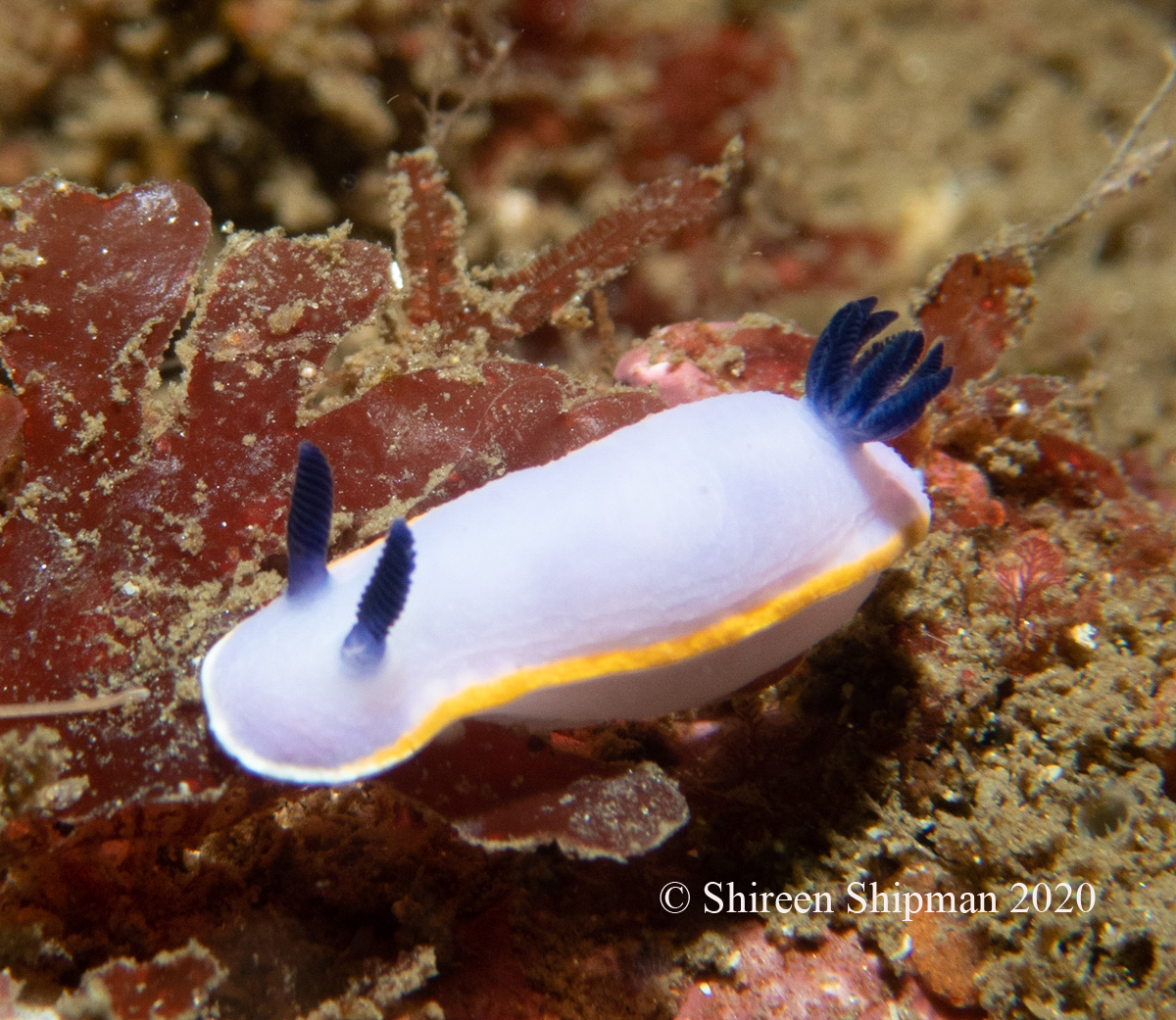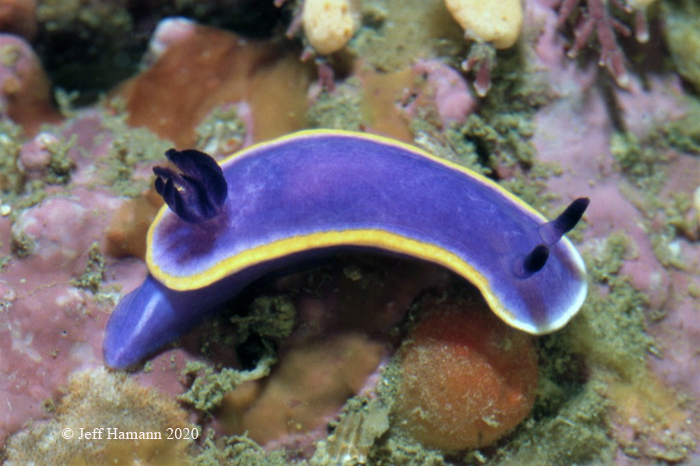 |
Image courtesy of Shireen Shipman
Dive Site Dino Head at depth of 75 ft. Point Loma, San Diego, Calif
Image courtesy of Jeff Hamann |
Felimare amalguae (Gosliner & Bertsch, 1998) This week's "Branch of the Week" is a lesson in just how much variation is possible between specimens of a single species of sea slug. Originally named Mexichromis amalguae, this species is quite uncommon and previously known from only two islands off the Mexican Pacific coast, Isla Cedros and Islas San Benito. It has since been moved to the genus Felimare by Johnson & Gosliner (2012), in their epic reorganization of the Chromodoridid species complex. Terry and Hans chose to name this species after the type locality of Isla Cedros. In describing the etymology of the species, they wrote: "When Isla Cedros was 'discovered' by the Spaniard Francisco de Ulloa in 1540, the island was inhabited by a tribe of Cochimi who called the island Amalgua, or Isle of Fogs. Shireen's critter collected at Point Loma fogged up attempts to ID it. Although Shireen's specimen was documented geographically a distant leap to the north, it is unmistakable that while the notal color is quite different from that of the blue - purple type specimens seen at left, it is characteristically Felimare amalguae, due to the yellow marginal band, white across the anterior edge, and the Navy-blue gill and rhinophores. Just because specimens occur far apart, does not mean that their differences in color mean they are not the same. I doubt that genetic sequencing will find these guys different. Not only is Shireen's find a rare one, but an unusual colored one as well. |
Gosliner, Terrence M., and Hans Bertsch. 1988. A new species of Mexichromis (Nudibranchia: Chromodorididae) from the eastern Pacific. The Veliger 31 (1/2): 127-134.
Johnson R.F. & Gosliner T.M. 2012. Traditional taxonomic groupings mask evolutionary history: A molecular phylogeny and new classification of the chromodorid nudibranchs. PLoS ONE 7(4): e33479
Dave Behrens
Sammamish, WA 98074
Oct., 2020
Send Dave Behrens email at davidwbehrens@gmail.com
Image courtesy of Shireen Shipman |
Shireen Shipman is a mechanical engineer working in the maritime industry. She has sailed as an engineer on ships up and down the coasts of the Americas, built engines for US Navy vessels, repaired US Navy Surface Fleet ships, and currently works in designing and building new ships in San Diego. She began diving and practicing photography two years ago. Although new to diving, she has spent a lot of time snorkeling, swimming, or playing water polo. She frequently dives the waters of Southern California and loves the diversity of the kelp forest. She has been published in The Washington Post. You can find more of her photos here:https://www.instagram.com/theshiplady. Photographic equipment used: Olympus TG-6 with Backscatter mini-flash. Send Shireen email at at shireen.shipman@gmail.com |

Attention all you Sluggers, and you know who you are! The NSSI 2nd edition is now available in ebook PDF and book form . The hard back version will become available Nov. 1st. Both will cost $65 (individually). You will need to jump through a few hoops to get the electronic version as pdf distribution is protected by Adobe ID!! Please read the following to enable reading your electronic purchase! This new 2nd Edition is updated and reorganized, including 185 new species. Among other features, the new edition includes additional photographs of species, an identification key, and an up-to-date classification reflecting the latest evolutionary relationships. The Indo-Pacific represents the largest expanse of tropical ocean in the world, stretching from the Indian Ocean coast of southern Africa and the Red Sea to the central Pacific of the Hawaiian Islands, Easter Island and the Marquesas. This region supports the most diverse marine fauna of any place in the world for most groups of marine organisms. The nudibranchs and sea slugs are no exception to this rule; there are about 3,000 described species of these organisms in the world and at least 40% of these have been found exclusively in the Indo-Pacific tropics. This book illustrates 2,138 Indo-Pacific nudibranchs and sea slugs, including many undescribed species.
|
